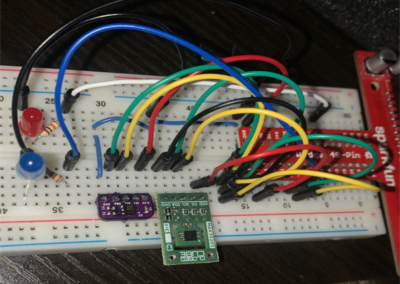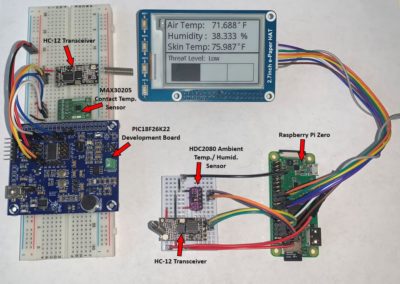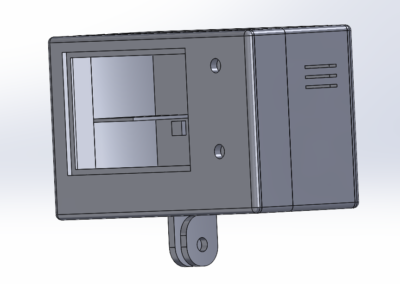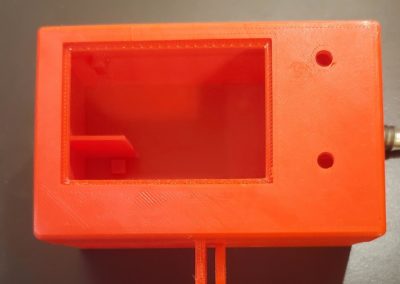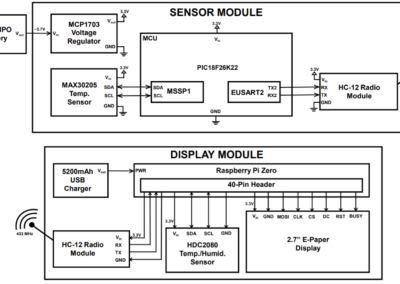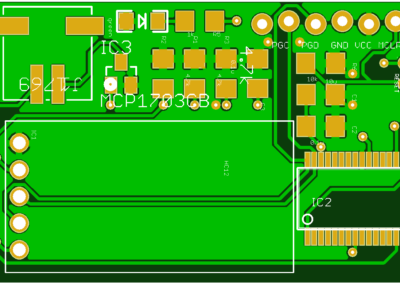Body Temp. Monitor for Quadriplegics
Overview

Topher Downham
Quadriplegia is weakness or paralysis in both arms and legs, typically stemming from a cervical spine injury. Depending on the severity of injury, a quadriplegic individual may have little to no control over their limbs.
Our client, Topher Downham, has C6-7 quadriplegia: he has no feeling in any part of his body below the lower chest, and he has limited mobility in his hands. He moves with the aid of a manual wheelchair and participates in activities such as hand biking, skiing, and other adaptive sports.
One problem Mr. Downham and many other quadriplegic individuals experience is the regulation of their body temperature. Quadriplegia typically inhibits the ability to shiver in response to cold weather and sweating in response to hot weather or physical activity. To thermoregulate, their bodies can only make use of local vasodilation and vasoconstriction reflexes in the paralyzed areas (i.e. increasing and decreasing bloodflow to the area), which is further limited by reduced musculature in those areas. Because of this, there is a higher chance to suffer from hypothermia in cold environments and heat stroke or hyperthermia in hot environments.
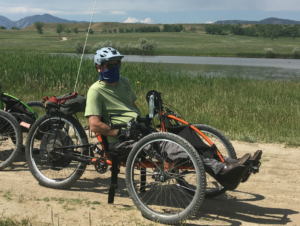
Mr. Downham on his hand-bike
The goal of this project is to design and implement a device with body-worn temperature sensors to alert Mr. Downham to dangerous changes in body temperature. Given that skin temperature is partially affected by ambient temperature and humidity, the design additionally includes ambient temperature and humidity sensors to aid in estimating the overall level of risk of hypothermia or overheating for the user.
Live Zoom Chat
Use the link below to join us live from 8:00 – 10:30 a.m. on December 3.
link: https://mines.zoom.us/j/3825685810?pwd=bDVFTUN3eHJSZitZUEtpVFJCNkVaQT09
Please use passcode: 6hZr2J
Or iPhone one-tap: 16699006833,3825685810# or 12532158782,3825685810#
Or Telephone:
Dial: +1 669 900 6833 (US Toll) or +1 253 215 8782 (US Toll)
Meeting ID: 382 568 5810
Password: 150101
International numbers available: https://mines.zoom.us/u/aetKHChca
Team Members
- Lucien Nuciola
- Larry Baker
- Austin Means
The Client
- Topher Downham
Acknowledgements
 Project Advisor: Dr. Chelsea Salinas, Dr. Joel Bach
Project Advisor: Dr. Chelsea Salinas, Dr. Joel Bach
Technical Advisor: Dr. Christopher Coulston
Elevator Pitch
Design Approach
Based on the design constraints established from discussions with our client, our product should be simple to install on a wheelchair or bike, use sensors that are easy to put on and take off the body, accurately measure and transmit skin temperature, and properly alert the user if dangerous conditions are detected. The device should be lightweight and unobtrusive to movement during activity, robust to physical damage, and have a minimum battery life of around 10 hours.
This project is a continuation from the Fall 2019 – Spring 2020 year. In approaching this project, the team considerably revised existing design choices to improve accuracy and ease of use. This included modifying the design of the mounted display unit (consisting of an e-Ink display and Raspberry Pi Zero for receiving and displaying the sensor data) and selecting new temperature and humidity sensors. Additionally, the connection between the sensor units and display unit was changed from a wired to a wireless connection via radio to reduce the impact of the system on our client’s mobility during physical activity.
Based on the client’s input, the housing was designed to be small, easy to mount on the metal bars of their wheelchair and hand bike, and adjustable to different angles. The client further suggested the display unit be usable with existing GoPro mounts for his convenience. Housing development did not begin until a final choice of computer for the display unit was made.
In determining the temperature and humidity sensors to use, two decision matrices were created to judge the characteristics of four similar temperature and humidity sensors. The criteria used in making these decisions were cost, durability, accuracy, and ease of use in interfacing with hardware. Of these criteria, it was considered most important for the sensors to accurately report body temperature/humidity and be durable in cold and wet weather conditions. These criteria were weighted accordingly in the decision matrices for the sensors.
From these rankings, the team chose to use the MAX30205 temperature sensor from Maxim Integrated for the skin temperature sensors and the HDC2080 from Texas Instruments for ambient temperature/humidity measurements. In order to test the reliability of these sensors, a wired prototype was first constructed consisting of the two sensors connected via breadboard to a Raspberry Pi 3 B+. After the team ensured accurate data collection and processing from the sensors, development of a wireless functional prototype began.
In order to facilitate a wireless connection between the skin temperature sensors and the display unit, the team decided to create a custom PCB for each sensor unit consisting of the temperature sensor alongside a programmable microcontroller connected to a wireless transceiver module. The team determined this to be the simplest method of implementing wireless communication based on available resources. The team selected to use the PIC18F26K22 microcontroller from Microchip Technology, Inc. because the team already had development boards utilizing this chip that were constructed in a previous course. Due to the team’s existing familiarity with this device’s development environment, the team was immediately able to begin developing a wireless prototype incorporating the chip and the temperature sensors in parallel to PCB development. The team consulted with the designer of the development board, Dr. Christopher Coulston, on technical issues relating to programming for the chip and PCB design.
For wireless communication, the team decided to use the HC-12 433 MHz wireless transceiver instead of alternative technologies (e.g. Bluetooth) due to its low power consumption and ease of interfacing with the chosen microcontroller.
Design Solution
The display unit design consists of an e-Ink display with an acrylic covering to ensure water-resistance, two spaces next to the display for the placement of yellow and red LEDs to indicate moderate and severe threat level, respectively, and ventilation openings on the side of the housing to allow for air to flow into contact with the ambient temperature/humidity sensor. On the bottom of the display unit is the microUSB port for connecting to a portable USB battery.
From prototype testing, the team determined that a 2500 mAh battery can reliably power the display unit for approximately 8 hours, and a 5700 mAh battery can reliably power the display unit for 16 hours. It is estimated, based on the current draws of the components present on the PCBs, that they will each last around 56 hours when powered by a 1000 mAh lithium-polymer (LiPo) battery. In order to ensure a LiPo battery will supply the correct voltage to the components on the PCB, the MCP1703 voltage regulator was added to the PCB design to reduce the supplied voltage from 3.7V to 3.3V.
From extensive research, it was determined that skin temperature cannot be reliably used as an indicator of core body temperature, so the scope of the project was slightly modified. The skin temperature sensors are not used to calculate core body temperature, but are simply used to indicate whether the user is at moderate or severe risk of hypothermia/overheating. It was decided that three sensors will be placed on the body, ideally at the top of the obliques, the triceps, and on the inner foot in the final product.
The threat level detection protocol begins once the user puts on the temperature sensor by performing a two minute calibration to get a baseline of the user’s skin temperature at that time. Next, the heat index–or the “feels like” temperature– of the environment is calculated using the data from the ambient temperature and humidity sensor. The heat index is calculated using the Steadman regression (or the Rothfusz regression if the result of the Steadman regression results in a heat index greater than 80°F). Both equations are courtesy of the National Weather Service’s Weather Prediction Center []. At each subsequent temperature measurement following the calibration period, skin temperature is then compared to the baseline temperature and the heat index to determine the threat level.
For over-temperature conditions, threat levels are first filtered by heat index along with heat advisory recommendations by the National Weather Service shown below. For each temperature range, the change in skin temperature from baseline is then used to determine threat level with decreasing tolerance as heat index increases, since there will be less margin for skin temperature to increase before overtemperature effects begin to take place in increasingly hotter conditions.

For under-temperature conditions, the heat index is significantly less important, and the primary method of determining risk is the change in skin temperature. The current design only includes one body-worn sensor, so thresholds must take into account the normal skin temperature ranges for the specific body part being measured. The aforementioned three sensor application will allow for much better under-temperature threat detection, as it can compare changes in skin temperatures per body part.
On the housing unit, these levels are indicated by both the display and by the yellow and red LEDs. These threat levels were determined based on the team’s judgement of existing data describing typical skin temperatures on different parts of the body and known average differences in skin temperature between typical adults and those with quadriplegia. Because of the number of variables that can influence skin temperature, these levels serve as only rough estimates of potential threat (see Next Steps section).
The skin temperature sensor unit consists of a two-sided PCB measuring 4.1 cm by 2.7 cm (dimensions not counting the LiPo battery, which is 3.8 by 3.2 cm in area). The “bottom” of the PCB (i.e. the ground plane) holds the MAX30205 temperature sensor to allow for direct contact with the skin. On the “top” of the PCB is the PIC18F26K22 microcontroller to receive the temperature data, the MCP1703 voltage regulator, pins for programming the microcontroller, space for the HC-12 transceiver module to be attached to the board, and a 2-pin connector for the LiPo battery.
Next Steps
There are several areas of our design that can be modified to improve functionality and ensure general robustness.
The method of determining moderate and severe threat levels must be adjusted to further take into consideration differences in skin temperature from quadriplegic individuals when abnormally hot or cold. There is currently very limited publically available data showing how skin temperature deviates from typical measurements in quadriplegics, and this data varies considerably from person to person based on a myriad of different physical and environmental variables. Measuring Mr. Downham’s skin temperature while he is actively using the device over the course of several weeks, and obtaining similar measurements from other quadriplegic individuals, will help verify existing research explaining the general trends in skin temperature for quadriplegics to ensure our product can be considered a reliable warning system for hypothermia or overheating.
Currently, the design built so far transmits data from a single skin temperature sensor to the Raspberry Pi Zero. In order to expand the functionality to the planned three sensors, it is proposed that a future team modify the firmware for the sensor microcontrollers to give each sensor a unique ID appended to the data it transmits. By allowing the Raspberry Pi to distinguish the data from multiple sensors, and by changing the frequency of data transmission to prevent the sensor data from intefering with each other and corrupting the resulting displayed temperature, the team believes this will ensure reliable device operation and allow for additional sensors to be easily manufactured and incorporated into the overall product. There was limited time to test this functionality, but these changes are not expected to involve more than simple modifications of the existing code.
The method of adhering the temperature sensor units to the skin can be further refined through the use of reusable adhesive patches. Minor testing will need to be done to determine which types of patches and methods of application are most convenient for quadriplegics with limited hand and arm mobility.
Additionally, the water-resistance of the housing unit and skin temperature sensor patches may be tested more thoroughly to further ensure that water does not harm any electronic components during outdoor activities.
Meet the Team
Lucien Nuciola
 Lucien Nuciola is a senior in Electrical Engineering. His hobbies include playing guitar and writing music. After graduation, he plans on working at Texas Instruments as an analog design verification engineer.
Lucien Nuciola is a senior in Electrical Engineering. His hobbies include playing guitar and writing music. After graduation, he plans on working at Texas Instruments as an analog design verification engineer.
Larry Baker
 Larry is a senior in Electrical Engineering with an emphasis in Integrated Circuits and Electronics and minors in Applied Mathematics and Data Science.
Larry is a senior in Electrical Engineering with an emphasis in Integrated Circuits and Electronics and minors in Applied Mathematics and Data Science.
Austin Means
 Austin Means is a senior at Mines studying Mechanical Engineer. He is from Frenchtown, Montana, and was a varsity mens basketball player for 4 years.
Austin Means is a senior at Mines studying Mechanical Engineer. He is from Frenchtown, Montana, and was a varsity mens basketball player for 4 years.
